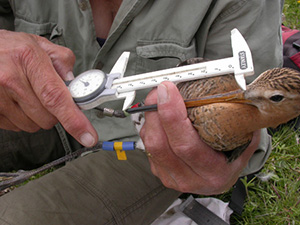Godwits are real high-fliers
The Dutch national bird, the black-tailed godwit, spends more than 20% of its migration flying time at very high altitudes en route to its West African wintering grounds. Altitudes of at least five kilometres and sometimes nearly six are not unknown. This has been revealed by new research, published this week in the Royal Society Journal Proceedings B, by Dr Nathan Senner of the University of Groningen / University of Montana and his team. The results are amazing because godwits are true lowland birds. They should lack the physiological adaptations needed to fly at altitudes where the partial pressure of oxygen is less than 50% of that at sea level, particularly to the red blood cells. Only the geese that migrate over the Himalayas ought to be able to do this.
In this remarkable study, postdoc researcher Nathan Senner and colleagues from the UG and the University of Amsterdam used GPS trackers to measure the flying altitudes and wing beat frequency of migrating godwits. The data were combined with information about wind, temperature and air pressure. In addition to the noticeably long periods of time that godwits fly at high altitudes, the fact that they do this despite there being no topographical barriers to cross stands out. The very high flying altitudes may be related to avoidance of high air temperatures at lower levels. Godwits also benefited from more tailwinds at higher altitudes.

Sport performance
Nathan Senner: ‘Nearly 20% of all birds annually migrate long distances between their breeding grounds and their wintering grounds. These treks require legendary “sport performances” – performances that turn our ideas about the limits to endurance and physiology upside down. Take the treks by bar-tailed godwits across the Pacific Ocean, 11,000-12,000 kilometres non-stop from Alaska to New Zealand. And what about the treks by geese over the Himalayas. Our own godwits had even more surprises in store for us, though!’
Revised ideas
Thanks to these results, migratory bird biologists have had to revise their general ideas about the frequency of high altitude flying. Lowland birds have a greater capacity to fly high than they considered even possible. Flights at high and extremely high altitudes are probably a lot less unusual than we’ve always thought.
| Last modified: | 16 July 2018 2.51 p.m. |
More news
-
13 May 2024
‘The colourful cells of petals never get boring!’
Most people will enjoy colours in nature. However, the interest of evolutionary biologist Casper van der Kooi goes much further: he studies how flowers, birds, butterflies, and beetles get their colours. He also studies how these colours are used...
-
13 May 2024
Trapping molecules
In his laboratory, physicist Steven Hoekstra is building an experimental set-up made of two parts: one that produces barium fluoride molecules, and a second part that traps the molecules and brings them to an almost complete standstill so they can...
-
07 May 2024
Lecture with soon to be Honorary Doctor Gerrit Hiemstra on May 24
In celebration of his honorary doctorate, FSE has invited Hiemstra to give a lecture entitled ‘Science, let's talk about it’ on the morning of 24 May
